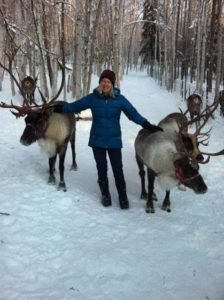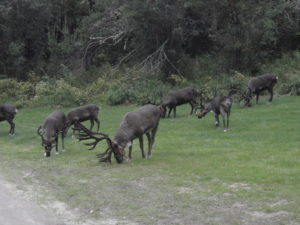
I cringed as the tip of the reindeer’s wide antlers brushed against my elbow. The terrain in the boreal forest at the Running Reindeer Ranch was slightly hilly, and if the animals behind me lurched ahead maybe they would knock me down.
“Don’t worry. They are the gentlest animals ever, and I can tell that they are happy to walk with you, said their owner Jane. ” I believed her when I saw that they were spread out and trotting upward between the trees.
“Queenie is the leader of the group,” she said, as she put a rein on his collar and asked our friend Jerry to lead him.
Jane had introduced us to her reindeer while they were grazing on the lawn in front of the house. Now she began to talk as if she were the mother of many children, each with distinctive personalities: Daisy, and Queenie, plus Willow, Buttercup, Moose, Rocky Cupcake, and Jasper.
Jasper, her wild troublesome charge, had to be castrated because he gradually got out of control. Following that episode, he developed an infection in his antlers and had to have them removed. Hence the velvety bumps on the top of his head. Though reindeer know how to avoid dangerous berries, at a young age Jasper lost his judgment and swallowed one of the baneberries.
As Queenie, the obedient girl child of the group, led us up a path that wound around uphill from the house. The other reindeer alternately nibbled lichen from the birch trees and bent down intermittently to eat spruce grout and other seeds and berries from the ground.
“Willow is not the best mother,” Jane told me. “She’s loose and free reign, and does what’s necessary, but you can see her looking over at her children in a distracted manner as if to say, ‘Oh, you’re fine.’ Ruby, on the other hand, is a Supermom—most attentive and affectionate. “I’m not breeding her anymore, however since she’s produced calves for a number of seasons (get #), and it’s time for her to stop.”
While we walked along one of the deer bolted ahead. “Daisy, you are going to far. Stay with us.” Daisy obeyed and circled around toward us.
Jane explained that, unlike tropical woodlands, the Alaskan forest is austere, and supports a relatively low number of species and organism. The plants and animals adapt to the ecosystem. “Spruce grouse thrive in these evergreen dominated boreal forests,, and provide a rug-like coating on the floor In the winter I bring the reindeer lichen from the trees bunched up in my hands and feed it to them in the barn. For the little ones I start them on lichen early. It’s so rich with a combination of nutritious fungus, algae and bacteria—such a wonderful supplement to breast milk.”
When I saw that one had been scratching at a bloody spot, Jane said blithely, “That’s because it’s antler shedding time for him.”.
When I asked about how she got started with reindeer, Jane said that her daughter really wanted a large animal for a pet, and began to make suggestions. Goats. Yuck, Jane thought. Horses, too much work and too expensive. Dall sheep with huge twirling antlers. No way! “How about reindeer. They are so Alaskan!”
Jane said yes, and told Robin that she should do research on how to raise them. “A while ago Sami were brought in from Norway to work with the natives on methods for caring for the reindeer, so there’s lots of material on proper care and nutrition.

Not long after the animals arrived, Robin left for college, and now comes home only for intermittent vacations. Instead of bemoaning the fact that she was left with her child’s pet, Jane started her business: Running Reindeer Ranch. She gives three hour walks through the hills surrounding her property.
We continued walking as the herd scampered ahead, springing gracefully from their heels and weaving in and out of the trees. “What about predators?” I ask. “Eagles will try to get calves. We also have to watch out for brown bears, wolves, hawks and ravens. They are only out when we are home. “
Since they are sequestered together so much I ask about mating. “In the breeding season we separate them just as you would with cows or horses.. They mate from late September to early November. Calves are then born the following May or June, and are able to graze and forage when they are 45 days old. They nurse until fall and then become independent.
A few days later we were at a public park where six reindeer were slowly meandering inside a caged in area. Their coats were mangy, their waste had not been cleaned up, and they looked hungry. I wanted to swoop them up and take them back to the Running Reindeer Ranch.
Jane gives her walks all year long. Check the website for availability. http://runningreindeer.com/
